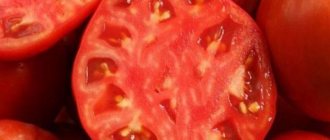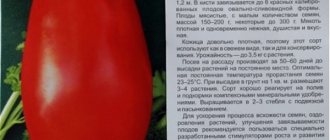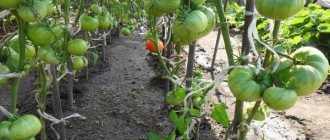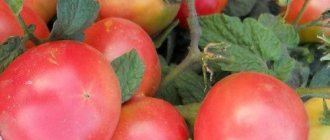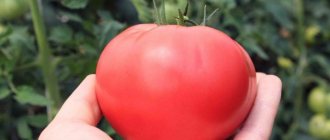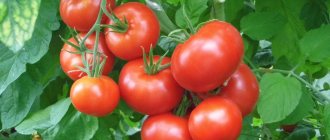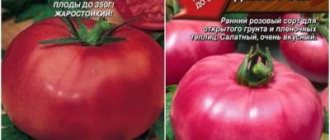The Far Eastern pink tomato is an excellent large-fruited variety that will delight lovers of fresh tomatoes and vegetable dishes. It has juicy and aromatic flesh.
| Height | Landing location | Ripening time | Fruit color | Fruit size | Origin | Fruit shape |
| Medium height | Greenhouse, Open ground | Mid-season | Pink | Large | Variety | Round |
Growing, varieties, processing of tomatoes (tomatoes) - advice from summer residents and gardeners
How to grow a good harvest of tomatoes, varieties, care, processing and other tips from experienced gardeners.
Growing tomatoes in the Far East
I decided to write about how I grow early tomatoes in the harsh Far Eastern climate.
In our area, it is difficult to get an early harvest of vegetables, especially tomatoes, without a greenhouse. Thus, the average background night temperatures in May usually do not exceed 8-10°, and on top of that, recurrent frosts occur. I have a homemade greenhouse, unheated, made from window frames, with an area of 15 square meters. m (length 5, width 3 and height at the ridge 2 m). The top is covered with film, which I don’t remove for the winter.
I prepare the soil in the greenhouse in the fall immediately after harvesting. I water the beds with a solution of copper sulfate and dig them up. After digging, I repeat the treatment with vitriol. This is necessary because I have been growing tomatoes in a greenhouse for several years in a row. In mid-April, I cover the beds with plastic wrap to warm the soil. At the beginning of May, I dig them up and prepare holes for planting (40 cm in a row and 60 cm between rows), which I spill with a hot solution of potassium permanganate, which helps to avoid outbreaks of fungal diseases. 2-3 days after watering, I add garden humus, a glass of ash and a tablespoon of superphosphate into the holes. On May 7-10, I begin to plant flowering, hardened seedlings with a well-developed root system in prepared holes in the greenhouse.
I grow seedlings in the traditional way with picking and two transplants from small cups into 2-liter containers.
I prepare the soil for seedlings in the fall, using well-ripened compost.
To disinfect the soil and fight weeds, starting in January, I bring it into a warm room several times, waiting for the weeds to appear, and then take it out into the cold again. This helps to avoid diseases such as blackleg.
I sow seeds of tall and late varieties in mid-February, early and mid-season varieties
- at the end of February. Since the end of March, I have been placing the seedlings on the glazed southern side of the loggia, where they develop and are hardened until they are planted in the ground. After planting the seedlings in the greenhouse, I install arches on the beds and cover the plantings with covering material, and at the end of the greenhouse I place a 200-liter metal barrel of water. The barrel sits until late autumn, I change the water periodically, using it for irrigation. I water every 5-6 days, depending on the weather. Frequent watering is harmful - a powerful bush grows with a thick stem and large stepsons, which reduces the yield. Usually the plant itself tells you when it needs moisture. If the leaves noticeably wither, especially at the top of the bush, it means there is not enough moisture - watering is necessary.
June Harvest
My greenhouse is located from east to west. On the southern side I usually plant early-ripening and low-growing varieties, and on the northern side - tall tomatoes, which I form into one stem and regularly plant. During the growing season, I fertilize three times: during the period of fruit filling, during the period when ripe fruits begin to be collected, and during the period of mass fruit collection.
D I fertilize with compost tea with the addition of complex mineral fertilizer (3 tablespoons of garden fertilizer mixture per 10 liters of water) 2-4 liters per bush, depending on the condition of the plants, and only after preliminary watering, since the roots can be burned.
Tomatoes love moist soil. Therefore, a month after planting the seedlings, when the roots appear at the surface of the ground and loosening is difficult, I mulch the plantings with leaves, straw, and grass cuttings in a layer of 15-20 cm. Mulch allows you to keep the soil moist for a long time, prevents the appearance of weeds and helps to avoid excessive humidity in the greenhouse. When the air temperature rises (above 30°), I ventilate the greenhouse, since pollen is sterilized at high temperatures and is not capable of pollination. To do this, I open all the windows, the door, and if the temperature at night does not drop below 12°, I do not close the windows at night to avoid the accumulation of condensation on the ceiling.
To prevent late blight during the ripening period of tomatoes, I use an infusion of garlic. Its phytoncides help destroy pathogens of fungal diseases (pass 200 g of garlic through a meat grinder, add a liter of water, leave in a closed jar for two days, then dilute in 10 liters of water). It is better to spray in the evening. Fruits treated with garlic infusion are not affected by late blight even at an air temperature of +4°.
The first tomatoes in the greenhouse usually ripen at the end of June, the last ones are picked at the end of September. Of the early varieties in 2012, we were pleased with the harvest of tomatoes Kemerovets, Vidimno-invisimo, and of the mid-season varieties - Fidelino, Abakansky pink, Volovye serdtsa, all varieties are of Siberian selection. The tomato variety Cosmonaut Volkov turned out to be very productive. The bush is powerful, up to 2 m tall, the fruits are round, red, weighing up to 400 g, very beautiful and tasty.
V.Melnik.
To be continued
vsaduidoma.com
Far Eastern tomatoes
In the Far East, tomatoes are loved and grown in greenhouses, under temporary shelters, and simply in a field or garden bed. Unlike cucumbers, which in the harsh Far Eastern climate are susceptible to peronospora and other fungal diseases, tomatoes practically do not get sick and turn out well.
Zoned varieties of tomatoes for the Far East
Each summer resident has his own proven set of varieties, which, nevertheless, is diligently replenished as soon as new specimens appear on the horizon. However, experienced gardeners know that the tomato assortment must include zoned varieties, especially those of the Far Eastern selection. They were bred in the local climate, therefore, they are perfectly adapted to it and in the most extreme conditions they will be able to help out and not leave them without a harvest. As they say, where you were born, you came in handy. At the same time, it is possible to grow Far Eastern varieties in other regions - if tomatoes survive in the Far East and produce full harvests, then in Siberia, the Urals, and the middle zone they will delight tomato growers with ripe, healthy fruits.
Let us remind you that tomatoes are a self-pollinating crop, and you can always easily collect seeds from varietal tomatoes. Hybrids in the second generation do not retain their parental properties and characteristics, so the seeds must be purchased anew each time.
Proven tomato varieties for the Far East
In the Khabarovsk Territory, they have been breeding tomato varieties for a very long time. Several good varieties were obtained, but at the dawn of various perestroika times, almost all work was stopped, and the varieties were lost. However, fortunately for us, one “veteran” has survived - the proven Khabarovsk pink variety 308
. For about half a century it has not left the shelves of our stores, and therefore from the Far Eastern gardens.
This variety is mid-season, pink round fruits (80-100 g) are good for any use. The fruits ripen smoothly and are resistant to the main tomato diseases in our climate.
Photo: Khabarovsk pink variety 308
New varieties of tomatoes for the Far East
Time does not stand still; work on tomato selection is being carried out quite successfully. New varieties have been obtained with different ripening periods, bush shapes, colors and shapes of fruits.
Dawn of the East
Zarya Vostoka is of particular interest.
, which is an improved sample obtained as a result of more than ten years of selection from our variety
Amurskaya Zarya
.
By the way, seeds of the Amurskaya Zarya
, which we did not transfer to the State Variety Testing, because took a long time to be finalized. However, this variety is available in the State Register of Breeding Achievements, and the seeds come from somewhere. I recommend that you always purchase seeds from reliable suppliers, or better yet, from the originators of varieties, because seed producers often engage in rather lengthy reproduction (reproduction), without complying with established norms and requirements and violating the copyrights of breeders.
- The Zarya Vostoka
variety is characterized by fast ripening, medium-sized, high-yielding. - Plants produce the bulk of their harvest in the first 10-15 days of harvest.
- The fruits are quite large (about 150 g), mostly round, sometimes slightly flat, have an excellent taste, and are universally used.
- Plants do not need to be pinched and stakes are not used for garter.
Photo: variety Zarya Vostoka
Amur cliff
The most favorite is the indeterminate (requires pinching over the 4-5th brush) standard variety Amursky Utes
.
- Its seedlings are especially good: stocky, with a powerful root system. These qualities were immediately appreciated by entrepreneurial gardeners who grow seedlings for sale.
- The fruits, large (65-75 g) oval cream, will not disappoint either. There are always a lot of them on the bush, they ripen together, and do not crack either during ripening or during pickling.
- I think this is the most suitable variety for canning. I usually preserve it myself and recommend it to others.
Photo: Amur Cliff variety
Dunyasha
You will definitely like another Far Eastern variety – Dunyasha
.
One summer resident once told me that he had long forgotten the taste of tomatoes from his childhood. Everyone, they say, is somehow “not like that.” So it was our Dunyasha
who turned out to be like that.
- The variety belongs to the group with medium ripening periods, determinant.
- In plants that usually limit their growth to the fourth cluster, it is recommended to tear off the stepsons and, given the fairly high yield, should be tied to stakes.
- The fruits themselves are orange-red, have a smooth round-oval shape, very fleshy, quite large, up to 150 g.
- The first ripened fruits are especially tasty for fresh consumption and salads. Since the variety has a long fruiting period, fruits from the second and higher clusters (the first cluster usually produces larger fruits) are perfect for canning in jars.
Photo: Dunyasha variety
The best varieties of tomatoes. New varieties of tomatoes for the Moscow region
Every year, gardeners go to purchase seeds of new varieties of tomatoes. This does not mean at all that wonderful old varieties of tomatoes have been forgotten, but everyone wants to believe that a new variety or hybrid will be better, more productive, and more stable. The peak demand for tomato seeds occurs in February-March and this is no coincidence. Tomatoes for seedlings are planted around mid-March, which means before this time you need to learn as much as possible about new products, exchange opinions and re-read reviews from summer residents about the tested varieties.
It would be easier if there were few new varieties of tomatoes, but today breeders have developed so many varieties that it is easy to “get lost” in them. How can you choose the best variety of tomatoes from the variety of seeds presented, bright pictures on the bags and many reviews?
Let's try to figure out which tomato varieties are best to plant in the new year 2014. What to pay attention to when buying and how not to fall for the bait of unscrupulous sellers.
Favorite old varieties of tomatoes
It's no secret that gardeners have their favorite old varieties of tomatoes, proven over the years and experience, which they will never give up. For some, these are varieties with early ripening, others prefer yield and taste, others like the habit of the bush and the resistance of the tomato to diseases.
Let's look at the most popular tomato varieties tested among gardeners, which they grow every year.
The first place among this group is confidently occupied by tomatoes of Siberian selection. They are loved by many gardeners.
Tomato variety Eagle's beak
This variety is mid-season for open ground greenhouses. Plant height is from 1.2 to 1.5 m. The fruits are raspberry-pink in color. The eagle beak tomato is so named because of the peculiar shape of the fruit, reminiscent of the powerful curved beak of an eagle. The weight of such a tomato reaches 800 g. Eagle beak tomatoes have a long shelf life and are good for preservation. Productivity - up to 6-8 kg per bush. Summer residents consider the Eagle Beak variety to be the best among large-fruited tomatoes.
Tomato variety Siberian early ripening
This tomato variety is determinate (short with limited growth) with a height of 50-90 cm. The variety is early ripening, it can be grown in film greenhouses and in open ground. The fruits are flat-round and small, weighing up to 100g. The Siberian early ripening tomato variety is so popular due to its stable yield, despite various weather conditions.
Tomato Eternal Call
Tomato Eternal Call is an early-ripening, determinate variety. The fruits are very large, up to 900g. It is grown both in film greenhouses and in open ground. The fruits of this tomato variety are glossy red, very fleshy, with a delicate sugary taste. Eternal Call is suitable for fresh consumption and canning.
Tomato Siberian Trump
Siberian Trump is a large-fruited, mid-season tomato variety for open ground. The height of the plant is 80 cm, it requires a garter. Raspberry-red fruits can weigh up to 700 g.
Tomato Siberian Troika
Siberian Troika is a mid-season variety, determinate up to 60 cm (with limited growth). The fruits are elongated, dense and very fleshy. The tomatoes weigh from 150 g to 300 g. The variety is high-yielding.
Variety from Siberian breeders - Far Eastern tomato Slice: detailed description of tomatoes
The Far Eastern tomato Dolka was created by Siberian specialists. It has an interesting shape, reminiscent of fruit slices, excellent taste and aroma, and a universal purpose.
| Height | Landing location | Ripening time | Fruit color | Fruit size | Origin | Fruit shape |
| Tall | Greenhouse, Open ground | Mid-season | Pink | Average | Variety | Plum-shaped or oval |
Description and characteristics of the variety
This variety is semi-determinate; plant height is 150-170 cm, occasionally reaching 2 meters. The leaves are ordinary, small, dark green. The bushes are not very spreading.
According to the ripening period, the Far Eastern tomato Dolka is mid-season. The fruits have a graceful oval-elongated shape, tapering towards the top, some may have spouts. The color of a ripe tomato is deep crimson. The weight of the fruit can range from 80 to 300 grams.
The skin is dense, the flesh is grainy, juicy, and has a sweet and sour taste. There are two seed chambers, there are few seeds in them. Tomatoes are suitable both for fresh consumption and for processing into juice and canning whole.
Advantages and disadvantages
- excellent taste;
- beautiful appearance;
- the fruits do not crack.
Minuses:
Features of cultivation and storage
Tall bushes need support, so a vertical trellis or strong stakes are required. Plants should also be pinched. It is best to leave 2 stems.
For 1 sq. m. no more than 4 bushes are planted.
Tomato Oxheart
Bull's heart is a late-ripening tomato for open ground and temporary film shelters. This tomato variety, although determinate, requires staking and formation. Ox heart is classified as a salad tomato variety. The fruit is heart-shaped, smooth and fleshy, weighing up to 200 g, and is one of the most delicious tomatoes. Probably, gardeners love it for its taste. By the way, the varieties Bull's Heart raspberry and Bull's Heart pink have appeared. differing in color and size of the fruit. The largest of the "bull" company is Bull's heart raspberry up to 600g.
Tomato Black Prince
The black prince tomato has an unusual dark shade. This variety is mid-season indeterminate (2m and above in height) with fleshy, very tasty fruits. The variety is valued for its long fruiting period and resistance to low light. There were a lot of adventures with this variety of tomatoes because of its color; many “uninformed” summer residents threw away tomato fruits, thinking that the fruits were affected by late blight.
Tomato De Barao
Tomato De Barao is an old variety. It belongs to the indeterminate varieties (with unlimited growth). Designed for growing in greenhouses. Fruit weight 50-100g. Today, the seed market offers several varieties of De Barao with yellow, orange, pink, black and dark red fruit colors.
Caring for low-growing tomatoes: watering, fertilizing, pollination, weeding
The main thing in caring for tomatoes is regular watering. Once a week, bushes of low-growing tomatoes are abundantly watered at the root or along the grooves between the rows, spilling the soil several tens of centimeters deep.
To prevent late blight infection of tomatoes, you can add a drop of potassium permanganate to the irrigation water.
Expert opinion
Yulia Yurievna
I have a large garden and vegetable garden, several greenhouses. I love modern methods of cultivating plants and mulching the soil, and I share my experience.
Ask a Question
A good option would be to use drip irrigation, as this method saves the gardener’s effort and also reduces water consumption. This technique allows you to avoid watering weeds that may be located next to the tomatoes.
With drip irrigation, new branches of the rhizome may appear, which improves the nutrition of the bush. This in turn increases the quality and quantity of fruits, and improves plant immunity.
Regular fertilizing of vegetable crops also plays a big role in obtaining a high yield of tomatoes. Mineral fertilizers are applied for the first time after planting seedlings in the ground. Then after the ovaries appear. The fertilizer includes ten grams of ammonium nitrate or potassium sulfate per bucket of water.
Organic fertilizers in the form of mullein solution or bird droppings are also essential nutrition for the vegetable. Spraying tomato bushes with a solution of boric acid during the flowering period will stimulate the formation of new ovaries.
At low temperatures, the quality of pollen becomes worse, and at too high temperatures it dies.
Tomatoes are self-pollinating plants (photo)
Insects cope well with pollination. Therefore, in order to attract them to plant tomatoes, seeds of honey plants such as basil, mustard, and coriander are sown between vegetable plants.
Tomato bushes do not live well among weeds, and they must be constantly weeded by hand. To reduce the growth of weeds, you can use mulching with paper, black film or roofing felt, as well as sowing rye, peas, and wheat next to tomatoes.
There is no need to tie up low-growing tomatoes, although some experts recommend doing so: in a strong wind, the stem may not stand it and break under the mass of fruit.
There are several ways to speed up the fruit ripening process:
- Using a sharp knife, split the stem at the bottom of the bush, and to prevent the wound from healing, insert a match or a thin twig.
- Pulling the bush upward will lead to tearing of the roots and restriction of nutrition of the stems and branches. All useful substances will be used to ripen the fruit.
- Clusters of unripe tomatoes wrapped in a cellophane bag will begin to ripen faster and will be saved from late blight.
By mid-August, ripe tomatoes begin to be harvested. If the weather forecast is unfavorable, you can collect all the fruits and place them in a dark room to ripen.
New varieties of tomatoes for the Moscow region
Any summer resident would like to plant at least a couple of new varieties of tomatoes to try. What if they turn out better and become “heroes” of greenhouses, and their fame will be passed on to other gardeners? Among the new tomato varieties, several groups can be distinguished. Let's consider new varieties included in the State Varietal Register in 2013, zoned for the Moscow region. To make it more convenient, let’s distribute these varieties of tomatoes by height.
Tall varieties of tomatoes:
- Alliance F1 (semi-determinate, red fruits weighing 125g)
- Amerigo F1 (mid-early salad hybrid, large fruits 200g, excellent taste)
- Grandmother's happiness F1 (mid-season hybrid for film greenhouses, flat-round tomatoes of pink color, weighing up to 270g. Excellent taste.)
- Danubio F1 (tall plant, requires formation, red hard fruits up to 6 fruits in a cluster, fruit weight 220g, excellent taste.)
- Hummingbird (elliptical salad fruit, weight 116g, excellent taste)
- Kohava F1 (tall plant with flat-round, slightly ribbed fruits weighing up to 100g in a cluster of more than 5 fruits)
- Lancelot F1 (early ripening salad hybrid with excellent taste qualities. The fruit is round, red, weight up to 100g)
- Marya mistress F1 (early ripening salad hybrid. Round red fruits weighing 100g)
- Macho F1 (early ripening salad hybrid, fruit weight 160g)
- Tourist F1 (early ripening salad hybrid. Round red fruits, excellent taste, weighing 120g)
Low growing tomato varieties:
- Askold (early salad variety, does not require gartering or shaping, fruits weighing 60g)
- Boletus F1 (early ripe hybrid, requires gartering and shaping, round fruit weighing up to 100g, excellent taste)
- Budenovets F1 (early ripening determinate hybrid, requires garter, red heart-shaped fruits up to 100g, excellent taste)
- Bersola F1 (determinant hybrid of early ripening, round red fruits weighing up to 150g, excellent taste)
- Budenovets F1 (early ripening hybrid, plant requires garter, red-colored fruits for salad purposes, weight up to 100g)
- Vnuchenka (an early-ripening standard variety, small 20g salad fruits are suitable for whole-fruit canning)
- Dersu (standard plant, red fruits from 4 to 6 in a cluster, fruit weight 80g, good taste)
- Brownie F1 (early ripening salad hybrid, does not require pinching or gartering, round red fruits of excellent taste, fruit weight 30g)
- Fiery heart F1 (early salad hybrid, dense heart-shaped fruits, weighing 100g)
- Parsley gardener (standard variety, cylindrical fruit with a pointed tip, weighing 180g)
- Posyet (standard variety, cylindrical fruits of good taste, weighing 70 g, excellent for whole-fruit canning)
- Summit (salad variety ideal for whole-fruit canning, cylindrical fruits weighing 60g)
- Top model (large-fruited variety, round yellow tomatoes weighing 270g)
- Tribeca F1 (salad hybrid, round red fruits weighing 250g)
What varieties of tomatoes are the sweetest and most delicious?
When choosing tomato varieties or hybrids, it is important to consider the conditions in which they will be grown. You can choose varieties of tomatoes for greenhouses that have long gained popularity among many gardeners or purchase completely new varieties of tomatoes.
Hurricane F1. Early ripening. Smooth fruits up to 90g.
Typhoon F1. Early ripening. Round fruits weighing up to 90g.
Friend F1. Early ripening. Plant up to 70 cm high. Bright red fruits are round in shape, medium in size. Fruiting is friendly.
Semko-Sinbad F1. Early ripening. Round tomatoes, red, 90g.
Blagovest F1. Valued for its friendly and early maturation. Round vegetables weighing 110g.
Kostroma F1. Mid-early. Tomatoes weighing 125g.
Ilyich F1. Early ripening and high-yielding. The plant is disease-resistant and produces tomatoes weighing 140–150 g.
Search F1. Early ripening and high-yielding. The plant is up to 1m high and produces high quality fruits. Resistant to diseases and temperature changes.
Samara F1. Early ripening. Dense, smooth round tomatoes, 80g each. Excellent taste. Simultaneous ripening makes it possible to harvest with brushes.
Tornado F1. Universal hybrid. The plant is 1.5 - 1.8 m high. Mid-season. Bright red round tomatoes weighing up to 90g.
Verlioka F1. Determinate type plant. Valued for its vigorous and early fruiting. Productivity is average. Smooth, round fruits.
Caspar F1. Tomatoes are pepper-shaped, fleshy, dense. The pulp is rich. Excellent for canning. It is also grown in open ground.
Orange Mid-early. Orange fruits, tasty and dense. Can also be grown in open ground.
Junior F1. Ultra early ripening. Bush up to 60cm high. Slightly leafy. Bright red fruits, slightly ribbed or smooth, weighing up to 100g. One plant can produce 2 kg of vegetables.
Amber. Ultra early ripening. Good for northern regions. The low-growing plant produces round, yellow tomatoes.
Dina. Early ripening. No pinning required. The bush produces very tasty, fleshy yellow fruits.
Semko-98 F1. Early ripening. Tomatoes weighing up to 80g. Round-flat, uniform color, smooth. The plant is resistant to late blight.
Many gardeners simultaneously plant varieties that differ in taste. Some of them are more suitable for canning, others for making sauces or tomatoes, and others for fresh consumption. We’ll talk about growing the latter in more detail.
Tomato varieties popular among summer residents
Now let’s talk about the most popular and well-known varieties of tomatoes among summer residents.
The Persimmon tomato variety is one of the most popular varieties of yellow tomatoes.
Persimmons are not even yellow; tomatoes are a rich, bright orange color. The persimmon variety has been zoned since 1999 and today it remains the favorite variety of many summer residents. The fruits are fleshy, large and round in shape. The value of the variety is its high productivity, sweetness and increased beta-carotene content in the fruits.
Tomato Blagovest F1 is familiar to many gardeners.
Evenness of fruits, good yield when grown in greenhouses, good taste, height up to 1.5 m - these are the qualities that are valued in this hybrid.
Tomato Verlioka plus F1
This is a determinate, medium-sized (up to 1.5 m) hybrid for greenhouses. Early ripening. The period from germination to the beginning of ripening is 100 - 105 days. The fruits are round, smooth, red, weighing 80-90 g. Universal use and resistance to tobacco mosaic virus, cladosporiosis, fusarium give this variety the right to be so famous.
The Pink tomato and a whole series of Pink hybrids are also well known to gardeners.
These are tall tomatoes with pink fruits weighing from 115 to 250 g.
Tomato Octopus
The Octopus tomato or, as it is also called, the tomato tree, caused a lot of noise and controversy in its time. When buying this variety, you should know that the Octopus tomato is intended for the southern regions when grown in greenhouses. This hybrid has unlimited growth, long shoots and you will not be able to get large yields in standard greenhouses in the Central Region, and even more so, you will not be able to grow a huge tomato tree from this variety.
Growing tomatoes Far Eastern slice using Dutch technology
Currently, there are many techniques for growing tomatoes, but the most popular and effective is the Dutch one. Thanks to this method, you can collect the maximum amount of harvest, and the fruits themselves will ripen juicy, aromatic and retain all their taste.
Specifics of the method
- At the time of rooting of seedlings, a special mineral wool substrate is used. Soil is not used, as it may contain various bacilli of infectious diseases, fungi, and pests.
- To feed seedlings, ready-made fertilizers are used, which contain all the necessary nutrients.
- Use of carbon dioxide during photosynthesis.
- The seedlings are pollinated by bumblebees and hornets, which are launched at the moment of abundant flowering of tomatoes.
Sowing seeds using the Dutch technique
The first thing to do is to select high-quality and proven seeds. Before sowing, the substrate is abundantly moistened with warm water. Drainage is placed at the bottom of the container or plastic cup, and mineral soil is poured on top of it. Next, the seeds are placed in containers and covered with a small layer of sand and vermiculite (each layer no more than 1 cm). The containers are covered with a film cap and placed in a dark room, away from active sunlight.
After 10-13 days, after sowing the seeds in containers, the seedlings reach the desired size and are ready to be planted in larger cups or pots filled with mineral substrate.
Basic requirements for Dutch seedlings Far Eastern Slice:
- the presence of 10 leaves on the first fruiting cluster;
- not too large peduncle;
- a properly formed color brush should hang downwards;
- The thickness of the stems is from 1 to 1.5 cm.
Planting seedlings using the Dutch method
The soil where the seedlings will be planted is pre-leveled and covered with a polyethylene film to ensure better reflection of the direct rays of the sun and protect the tomatoes from various pests. For 1 sq. per meter, 2-3 plants are planted, but if the greenhouse is well lit, you can plant from 2 to 6 tomatoes. The distance between seedlings should be 40-50 cm, and between the grooves 60-80 cm. The seedlings are planted, sprinkled with soil, watered abundantly with salt water and only at the root to avoid burns and damage.
In addition, air must always circulate in greenhouses. This can be done using classic ventilation or a regular room fan. Tomatoes grow favorably at air humidity from 65% to 75%. If the humidity in the greenhouse is below 55%, the pulp will be fibrous and dense.
Caring for seedlings using the Dutch method
Once the seedlings have been planted in their permanent habitat, they need to be watered regularly and properly. The best way to water plants is drip irrigation. To do this, use plastic hoses with a connected watering valve and perforations at the bottom so that the seedlings are watered evenly. Watering Far Eastern Slice tomatoes is carried out taking into account several factors: soil condition, temperature in the greenhouse, day length. For irrigation, use ordinary running water (rain), but its temperature should not be lower than 15%.
Feeding seedlings
The method of fertilizing tomatoes using the Dutch technique involves fertilizing seedlings through leaf plates. Every week, in the late evening, the seedlings are mechanically sprayed with a solution of boron and magnesium. Calcium and pH levels in the soil are monitored. A lack of nutrients in the soil contributes to uneven ripening of berries and can cause rot on Far Eastern Slice tomatoes.
Harvest
I harvest early in the morning, four times every seven days. Most often, the fruits weigh much more in the morning than in the evening. In winter, the berries are picked even if their color is a little duller than usual. The collected tomatoes are placed in special containers, the bottom of which is lined with a sheet of rubber or polystyrene foam to avoid damage to the fruit. Ten days before the last expected harvest of tomatoes, the leaves of the seedlings are painted with ethylene to speed up the ripening of the last berries.
The Far Eastern tomato Dolka is the most delicious and productive variety, which is cultivated by many experienced summer residents on their property. The fruits are pleasant to the taste and are most often used for raw consumption, however, gardeners use smaller fruits for various sauces and preparations for the winter.
Tomato Pink drop.
Tomato of indeterminate variety, red, sweet. The growth period is 85 days, in the case of using seedlings to grow tomatoes.
Very small tomato fruits, weight 20-25g, oval, tasty, the fruit has a two-chamber body structure.
Tomatoes Pink droplet.
The presence of dry matter in tomatoes is 65%. The clusters on the tomato bushes of the “Pink Droplet” variety are well structured, with 8-10 fruits not spreading.
The tomato variety is immune to TMV, black spot, and Alternaria. The yield of tomatoes of this variety is impressive and comparable to large-fruited tomato varieties (up to 13 kg/m2). Canned whole fruit.
Tomato Spartak.
The tomato variety is determinate, in the middle stage of early ripening. Tomato bushes are strong, multi-leafed.
Spartak tomatoes.
Tomato fruits are round-shaped, red, weight 140-190g. The strong ability of tomatoes of this variety is the uniformity of fruit shapes and good marketability in bazaars and markets.
Large tomatoes in a thick shell with partitions, elastic, tasty. The productivity of tomatoes of the Spartak variety is high and resistant to Alternaria.
Advertisements.
frukta.ru
What varieties of tomatoes to choose for the new season
Early and late tomatoes
All tomatoes according to their ripening period are divided into 4 groups: super-early, early, mid-ripening (they produce a massive harvest) and long-term (usually they are late-ripening, but this is not always the case). But since this crop is grown by seedlings, depending on the time of planting, their maturation also occurs.
As a result, it turns out that the division into early and late varieties is very relative. For example, some gardeners who sowed very early varieties at the very last date (or even straight into the ground - such an innovation appeared, alas, not at all suitable for our Ural region. I sincerely do not recommend conducting such experiments, even if it says on the bag of tomatoes you bought that they are suitable for sowing directly into the ground), they look with envy over the fence to their neighbor, whose mid-ripening fruits, sown in February, have long been turning red.
Extra early or super early ripening varieties of tomatoes
Despite all of the above, the group of tomatoes whose fruits ripen with minimal total solar energy consumption belongs to the super-early tomatoes. This group is characterized by:
- low sugar content of the fruit, which is quite understandable (after all, there was no sun yet, so why should tomatoes be sweet);
- short stature - their height usually ranges from 20-25 cm;
- low yield (no more than 10-15 pieces per bush), which is also understandable, because a small plant cannot potentially produce a large harvest;
- small fruits.
In a word, these are rather mediocre tomatoes, and it’s up to you to decide whether they are really needed in the garden. From my point of view, it is better to sow ordinary mid-season varieties earlier and plant the seedlings in the greenhouse earlier, creating ideal conditions for them. Then the harvest will ripen early. And the taste of mid-season varieties is better, and the yield is better - then you don’t know where to put the resulting harvest. But that's my point of view.
There may well be other considerations. Let's say you grow seedlings in an apartment without lighting, which means you cannot sow them early, because... the plants will not have enough light and will become very elongated. Then a compromise is quite possible, in which several plants from a series of super-early ripening ones can successfully complement the main harvest obtained from mid-ripening ones. Or maybe for some reason you were late with planting (alas, anything happens in our lives), you can’t get a harvest from mid-season varieties, and very early ones can still please you, albeit with a symbolic harvest, but at least you’ll try your tomatoes in salads .
In general, there are many options and situations, but still you should not rely mainly on super-early ripening varieties. They will give you the first red tomatoes for salads, but the overall percentage of their participation should be low, say, for 100 tomato plants you can plant 3-5 bushes and no more.
Among the varieties and hybrids of this group I would like to note:
- Red banana with fruits weighing 70-80 g and bush height up to 70 cm;
- Bonsai - it has fruits weighing 20-25 g, and the height of the bush is 20-30 cm;
- Parodist is a new, very early ripening variety up to 40-50 cm high; is distinguished by its unique fruit set in all weather conditions; fruits weighing 140-160 g;
- Boni-M - flat-round, bright red fruits, weighing 60-80 g; Thanks to its high early maturity, it produces the entire harvest in two weeks.
Early varieties of tomatoes
After 10 days, just early tomatoes begin to turn red. These are, as a rule, small-fruited, berry varieties, all kinds of “cherries”, “pears” and “apples”. Most of them are pickling, and the main purpose is to ensure that the process of preparing salads is not interrupted. The exotic is also attractive: many of the early varieties look very attractive both on the bush and then in preparations in the case of whole-fruit canning. In addition, among similar varieties there are often varieties with very different fruit colors. For example, I will never forget the first time they brought me seeds of early tomatoes of the Garden Pearl variety from the GDR (about 18-20 years ago). It still seems to me, and despite today’s abundance, that I have never seen anything more spectacular and at the same time tender - their fruits were pearly, like real pearls, and had a soft crimson color. But this is, of course, a lyric, and in general the percentage of early tomatoes should also be small - 5-10 bushes maximum, because all the shortcomings of the super-early ones remain for them, although they manifest themselves to a lesser extent.
The list of early good varieties and hybrids is very long. In this list it is worth noting the following:
- Atom is an early ripening determinate variety up to 60 cm high, standard, with fruits from 80-100 g to 150;
- Baloven is an unpretentious, early determinate variety with abundant fruiting and early and friendly ripening; fruits weighing about 85 g;
- Batyr F1 is an excellent early-ripening determinate hybrid with fruits weighing 80-110 g, uniform ripening and stable yield;
- Zlato Scythians is an unusually beautiful semi-determinate mid-early variety; vigorous plants, up to 1.2-1.5 m; fruits 100-120 g, golden-orange, very impressive and tasty, with a high content of carotene; the yield is quite high;
- Koenig F1 is one of the most competitive early vegetable products on the market, an early-ripening determinate hybrid with fruits weighing 80-120 g;
- Rosalia is an early-ripening semi-determinate variety with pink-raspberry, up to 100-120 g in weight, fleshy, juicy “watermelon” pulp, very tasty fruits; vigorous plants, up to 1.2-1.5 m;
- Khan is an early ripening determinate variety, one of the most delicious early tomatoes; medium bush, low, fruits weighing more than 110 g;
- Druzhok F1 is the highest yielding of the early ripening tomatoes; is distinguished by early and friendly yield of the harvest; the fruits are beautiful, round, evenly colored, weighing 80-100 g; has complex disease resistance.
Mid-season tomato varieties
Finally, after another decade, the tomatoes of the main, mass, medium-ripening group ripen - it is best to devote approximately 80 percent of the tomato area (or even more) to them. These are the ones you will eat fresh for most of the tomato season, and they are the ones that will be used for preparations.
Mid-season tomatoes, in turn, can be divided into subgroups: productive; disease resistant; delicious; large-fruited; multi-colored; with an unusual shape of the fruit, etc. Of course, some of the listed characteristics can be successfully combined in a certain variety, for example, tasty and large-fruited, but, alas, combining all this together as a whole does not work out very well.
The most productive varieties of tomatoes
Today, only heterotic hybrids (that is, those that are designated F1 on the bags) can be classified as productive today. It is from them that one can often expect an abundance of fruits with a fairly high resistance to disease and bad weather conditions, although this is not necessary. In addition, some amateur varieties fall into the same tomato category, which were obtained through spontaneous crossing by amateurs based on former “collective farm” varieties, once bred by Soviet breeders for the “plan”, public catering fermentation, production of juices and pastes.
In most cases, productive tomatoes are quite resistant to disease, transportable and have a strong, rough skin, but they often cannot be called tasty. In principle, all tomatoes whose packages indicate a yield of more than 8 kg per square meter are considered very productive. Listing them is an extremely thankless task, but I will name some of the most fruitful ones.
The new medium-ripening variety Tyutchev produces large, weighing 400-500 g red fruits of sufficiently high quality and for salad purposes; it provides a yield of 9-10 kg/m2. Resistant to a number of diseases.
The early variety Alaska is distinguished by good productivity with fruits weighing 85-94 g, a yield of marketable fruits in open ground of 9-11 kg/m2 and complex resistance to diseases. Sets fruit well under unfavorable growing conditions.
The salad variety Budenovka with spectacular heart-shaped fruits weighing 150-350 g gives a yield of 9.3 kg/m2.
The salad hybrid Harmony F1 with fruits weighing 90-94 g has a yield of 8-10 kg/m2. In addition, the variety is resistant to tobacco mosaic virus, cladosporiosis and fusarium.
And for the hybrid Gehlen F1 with fruits weighing 134 g, the yield of marketable fruits in unheated film greenhouses can reach even 16.2 kg/m2 with good care. The hybrid has complex disease resistance.
I have not listed here all varieties and hybrids with maximum yield, because... I would like to mention a number of them separately under the heading “Prolific and tasty.”
Productive and tasty varieties of tomatoes
As noted above, when creating productive varieties, breeders often pay little attention to taste, although there are pleasant exceptions. Let's say, for many years, sorting through productive varieties and hybrids and filling myself with a lot of cones, I still found some that were quite productive and at the same time tasty: these are Bityug F1 (yield - 8-10 kg/m2), Botticelli F1 (yield - 8-10 kg/m2), Viardot F1 (yield - 9.7-10.4 kg/m2), Dessert pink (yield - 9.8-12.4 kg/sq.m), Kirzhach F1 (yield - 31.8 kg /m2), Princess F1 (yield -14.9 kg/m2), Idol F1 (yield -14.2 kg/m2) and Nasha Masha F1 (yield - 7.5-9.8 kg/m2).
Svetlana Shlyakhtina
floraprice.ru
Tomatoes Slice Far Eastern, video
If you grew Far Eastern Dolka tomatoes, please write what you liked about this variety, and why it perhaps disappointed you. Will you grow it again? If possible, attach a photo of these tomatoes. Thank you!
Your reviews of the Dolka Far Eastern tomato and additions to the description will help many gardeners evaluate this variety more objectively and thus select the best varieties for planting.
Tomato Dolka Far Eastern is a rare variety that was first bred by Siberian breeders for cultivation in open soil and greenhouses. Regardless of the season, tomatoes produce a stable, good harvest.
Tomatoes differ from other varieties not only in the correct shape of the fruit, but also have an ancient taste that has been lost in many hybrids and new tomatoes.



